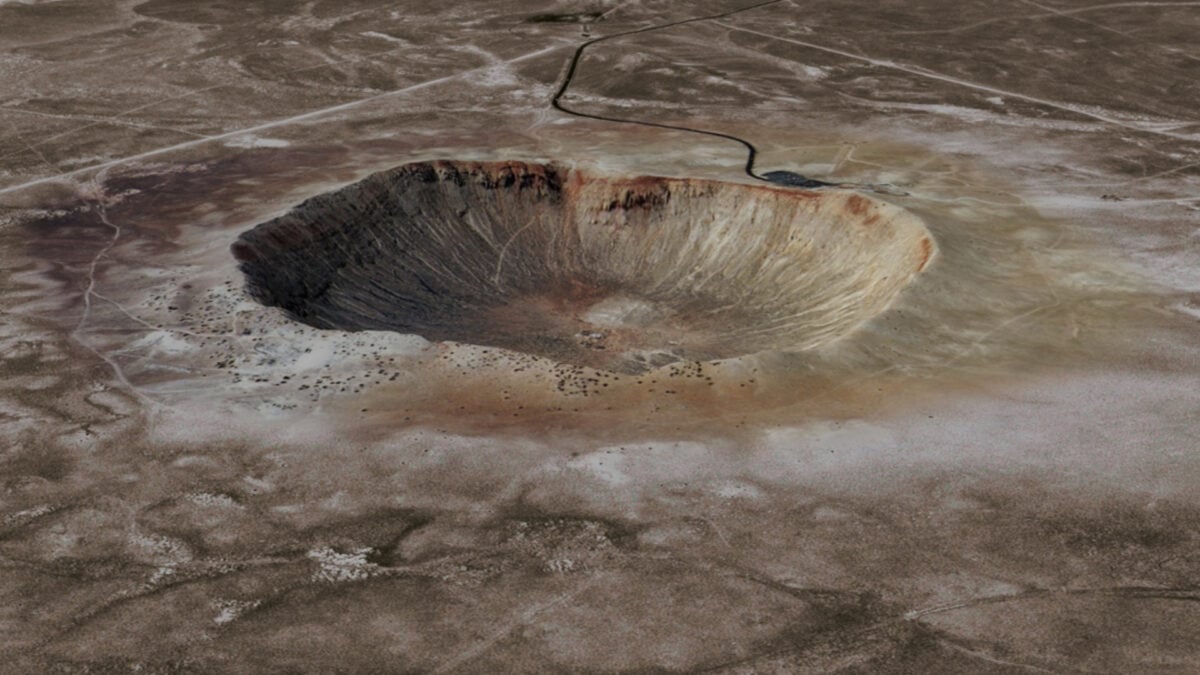A Meteor Impact May Have Caused a Giant Landslide in the Grand Canyon

Researchers have long puzzled over the presence of driftwood and lake sediments in Stanton’s Cave in the eastern Grand Canyon, whose mouth sits 150 feet (45.7 meters) above the river. How could the material possibly have reached that height? According to Karl Karlstrom, a geologist from the University of New Mexico, it would have had to be carried by flood levels ten times bigger than any seen in the past several thousand years.
An international team of researchers proposes a surprising chain of events as the culprit behind this mystery. They suggest that around 56,000 years ago, the meteorite impact that created Arizona’s Meteor Crater triggered a landslide large enough to dam the Colorado River and create a (now bygone) lake almost 300 feet (91.4 m) deep, which would have allowed the driftwood and lake sediments to float into the cave.
“Two iconic features of southwestern USA geology are linked by our hypothesis that the Barringer Meteorite Crater (Meteor Crater) impact in northern Arizona triggered cliff collapse in Grand Canyon 56,000 years ago that dammed the Colorado River,” the researchers, co-led by Karlstrom, wrote in a study published Tuesday in the journal Geology.
Scientists first came upon the mysterious driftwood in Stanton’s Cave in 1970, when yet unrefined radiocarbon dating techniques indicated it was over 35,000 years old. In the 1980s, one of the recent paper’s co-authors suggested the landslide theory—minus the meteorite impact—when he shared evidence of an ancient rockslide 22 river miles (35 km) downstream of the cave.

In 2019, Jonathan Palmer, another co-author of the study and a tree-ring specialist from the University of New South Wales, dated the driftwood to around 55,000 years old. When Palmer later visited Meteor Crater, he realized that the age of the formation—around 50,000 years—was oddly similar to that of the wood.
“Now there was this question, completely out of the blue, that nobody had asked before,” Chris Baisan, co-lead author of the study and senior research specialist at the University of Arizona’s Tree-Ring Lab, said in the university statement.
The researchers then recovered and dated additional sediment and wood samples from a site downstream from Stanton’s Cave, located at a similar height above the river, both of which turned out to be 55,600 years old.
“The mean of radiocarbon dates from driftwood, IRSL dates from cave sediment, and dates on the Meteor Crater impact converge into a narrow window of time at 55.60 ± 1.30 ka [55,600 years ago, +/- 1,300 years], which gives credence to the hypothesis that they were causally related,” the researchers explained in the study. What’s more, the team also found two places where river cobbles cover dam material, likely deposited when the river overflowed the dam and began to erode it.
As for the meteor impact, David Kring, co-author and Meteor Crater science coordinator, estimated that it would have caused an earthquake 100 miles (160.9 kilometers) away at the Grand Canyon with a magnitude of between 3.5 and 4.1. The event’s shock wave, blast wave, and impact could have triggered the landslide, Baisan explained in the statement.
“We put together these arguments without claiming we have final proof,” Karlstrom admitted. “There are other possibilities, such as a random rockfall or local earthquake within a thousand years of the Meteor Crater impact that could have happened independently. Nevertheless, the meteorite impact, the massive landslide, the lake deposits and the driftwood high above river level are all rare and unusual occurrences.”
As if meteorites weren’t scary enough, it seems like we might have one more thing to worry about if scientists’ projections for asteroid 2024 YR4 turn out to be wrong—giant landslides.









